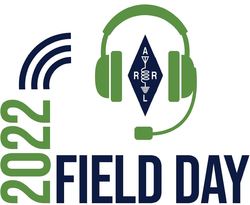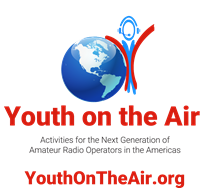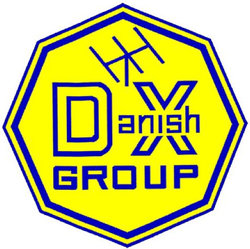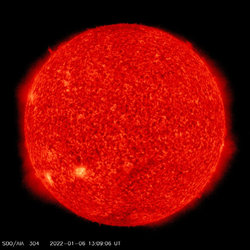 January 6, 2022 John E. Ross, KD8IDJ, Editor
| ||||||
ARRL Surveying Field Day Participants The ARRL Programs and Services Committee is seeking input from stations and groups that participated in ARRL Field Day 2020 and 2021 and has posted a survey. The committee said the survey results may help shape the development of Field Day rules for 2022 and beyond. The survey has already been sent via email to some 13,000 Field Day participants, more than 2,400 Affiliated Clubs, and to the "Specifically, as we look toward 2022 Field Day, health and social-distancing concerns may continue in June 2022 during the ongoing world pandemic," said ARRL Radiosport Manager Bart Jahnke, W9JJ. "For 2023 and beyond, the assumption is made that the pandemic will be over, and COVID-related restrictions will be relaxed." Jahnke said the Programs and Services Committee invites participants' insights, in advance of its January meeting, regarding what they consider appropriate for operating ARRL Field Day 2022 during the ongoing pandemic. The committee hopes to learn if participants prefer to continue Field Day under the pandemic accommodations afforded in 2020 and 2021, which included limiting home stations to the Low Power multiplier (150 W PEP), and whether stations in some classes or all other classes should be limited to 150 W PEP as well. Field Day stations operating at high power became the topic of some discussion in the wake of Field Day 2021, when some stations were reported to be running the legal limit on FT8 on crowded bands. The committee is also interested in views on the 150 W versus 100 W change in the Field Day Low Power category definition, which is being implemented across all contest platforms. During 2020 and 2021, ARRL permitted a couple of basic accommodations in the Field Day rules during the COVID outbreak. Participants who could not or did not want to be in a group were allowed to operate from their home stations and contribute their individual scores to their club's Field Day aggregate score. Members' scores were combined to achieve an overall final club score, which then appeared in the ARRL Field Day results summary in QST and on the ARRL website. In addition, Class D (Home, commercial power) stations were allowed to contact other Class D stations for point credit. In 2021, Class D and Class E (Home, emergency power) stations were limited to a maximum transmitter output power of 150 W PEP (Low Power). The idea here was to minimize the advantage of well-established home stations with superior antenna systems and running up to the legal 1,500 W PEP limit. Field Day participants may use this survey link or copy this URL into a web browser: https://www.surveymonkey.com/r/2022--ARRL-FIELD-DAY-SURVEY. The survey will close on January 17, 2022. Direct any questions to the ARRL Contest Department. ARRL Foundation Grants First-Year Funding for ARISS *STAR* Keith Pugh Initiative A $47,533 ARRL Foundation grant will fund the initial phase of the Amateur Radio on the International Space Station (ARISSâUSA) *STAR* Keith Pugh Memoriam Project. *STAR*, which stands for Space Telerobotics using Amateur Radio, honors the memory of Keith Pugh, W5IU, a highly respected member of the ARISS team who died in 2019. ARISS arranges live question-and-answer sessions via ham radio between International Space Station (ISS) crew members and students. A long-time and enthusiastic supporter of ARISS, Pugh was a star ARISS technical mentor, assisting schools with ARISS contacts, encouraging interest in ARISS among educators, and visiting schools to teach students about wireless radio technology. One goal of ARISS The ARISS *STAR* Project is a new educational initiative that will enable US junior and senior high school groups to remotely control robots via ham radio through digital APRS (Automatic Packet Reporting System) commands. Year 1 will focus on systems development and initial validation of ARISS *STAR*, and year 2 will focus on evaluation and final validation. Systems development and evaluation will be led by university staff and students who will undertake hands-on wireless and telerobotics lesson development, learn about amateur radio, and support *STAR* engineering hardware and software development. Next, youth teams will be selected to experiment and critique *STAR* telerobotics scenarios in closed courses. In the process, ARISS will encourage students to prepare for and earn an FCC amateur radio license, enabling them to use ham radio to learn and practice concepts in radio technology and radio communication. ARISS-USA Executive Director Frank Bauer, KA3HDO, praised the ARRL Foundation for its generosity. "ARISS team member Keith Pugh, W5IU, poured his energy into inspiring, engaging, and educating youth in space and in amateur radio endeavors," Bauer said. "What better way to honor Keith than through the ARISS *STAR* initiative. We thank the ARRL Foundation for its vision to move this initiative forward. Maybe someday one of our ARISS *STAR* students will use their telerobotics skills to control scientific rovers on the moon or Mars!" Over the past 2 decades, more than 1,400 ARISS contacts have connected more than 1 million youth with the ISS using amateur radio, with millions more watching and learning. The overarching goals for *STAR* are to improve and sustain ARISS STEAM educational outcomes. Robotics is gaining popularity among youth and adults alike, and telerobotics adds a wireless accent to robotic control. This will expand ARISS's educational dimension to attract the attention of more groups, students, and educators -- outreach that promises to attract new audiences. The ARRL Foundation was established in 1973, to advance the art, ARISS is a cooperative venture of international amateur radio societies and space agencies that support the ISS. US sponsors include ARRL, the Radio Amateur Satellite Corporation (AMSAT), the ISS National LabâSpace Station Explorers, and NASA's Space Communications and Navigation program (SCaN). The primary goal of ARISS is to promote exploration of science, technology, engineering, the arts, and mathematics topics. For more information, visit www.ariss-usa.org and www.ariss.org. ARRL Podcasts Schedule
The latest edition of Eclectic Tech (Episode 50) of the Eclectic Tech podcast -- the final edition for 2021 -- features a discussion with Nelson Sollenberger, The On the Air and Eclectic Tech podcasts are sponsored by Icom. Both podcasts are available on iTunes (iOS) and Stitcher (Android) as well as on Blubrry -- On the Air | Eclectic Tech. ARRL Welcomes New Director of Emergency Management ARRL has announced the hiring of Josh Johnston, KE5MHV, into the role of Director of Emergency Management. Johnston is from Ozone, Arkansas, and comes to ARRL with 16 years of experience as the Director of Johnson County (Arkansas) Department of Emergency Management. He holds an Extra-class amateur radio license and is an ARES® Emergency Coordinator, Volunteer Examiner, and ARRL-registered Instructor. Johnston is also certified in FEMA NIMS and is a Cybersecurity and Infrastructure Security Agency (CISA) AUXCOMM "I am happy to welcome Josh to the ARRL staff and to add his talent and knowledge to our team," said ARRL CEO David Minster, NA2AA. "His contribution will help ARRL continue to support our dedicated volunteers of the Amateur Radio Emergency Service®, improve opportunities for training, and advance our relationships throughout the EmComm community." With extensive experience in inter-agency cooperation and planning, Johnston is well versed in the different aspects of emergency management and leading both professional and volunteer operators. He has experience in communications planning and execution in the field and at the local and state level. As an Arkansas Master Certified Emergency Manager and past Board Member of Arkansas Emergency Management Association, where he served as president for 2 years, Johnston has experience working with government and agency representatives as well as boots on the ground in the field. Johnston will be based at ARRL's headquarters in Newington, Connecticut, working with staff and member-volunteers, and coordinating with the ARRL Board's new Emergency Communications and Field Services Committee (EC-FSC). Youth on the Air Camp to Return in June After a successful pilot camp program in 2021, the next Youth on the Air for the Americas camp has been set for June 12 - 17, 2022. The camp will return to the National Voice of America Museum of Broadcasting in West Chester Township, Ohio. The application period will open online February 11. Eligible participants are amateur radio operators between ages 15 and 25. A total of 30 campers will be accepted. Some of the 30 spots will be "We know that changes in the COVID-19 pandemic status between now and June will have an impact on hosting the camp," said Youth on the Air camp Director Neil Rapp, WB9VPG. "Should we not be able to host the camp or need to reschedule, we will let everyone know with as much notice as possible. Beginning in 2022, the camp will alternate as much as possible each year between June and July. Rapp says the camp planning working group acknowledges that avoiding all scheduling conflicts is not possible, but hopes that alternating months will provide some diversity with school schedules, extracurricular activities, and major ham radio events. Beginning in 2023, the location of the camp will rotate to various locations within the Americas. A system will be announced in which IARU member-societies and clubs will bid to serve as host of the region-wide camp. For details about the camp and/or to sign up for updates by email, visit the YouthOnTheAir camp website. Contact Rapp for more information. CAMSAT XW-3 (CAS-9) is Designated Hope-OSCAR-113 (HO-113) At the request of the Chinese Amateur Satellite Group (CAMSAT), AMSAT Vice President of Operations Drew Glasbrenner, KO4MA, has announced the designation of the new Chinese XW-3 (CAS-9) satellite as Hope-OSCAR-113 (HO-113). Developed by CAMSAT, in cooperation with the Chinese government's aerospace and education departments, XW-3 was launched on December 26 at 0311 UTC on a CZ-4C Y39 vehicle from China's Taiyuan Satellite Launch Center. The CW beacon frequency is 435.575 MHz at 22 WPM. GMSK telemetry is at 435.725 MHz. The amateur radio inverting V/U 100 mW linear transponder uplink is 145.870 MHz, and the downlink is 435.180 MHz. The transponder passband is 30 kHz. Kung said, "A space camera carried on the satellite has undergone preliminary engineering tests, and the download function of compressed photos will be opened to amateur radio enthusiasts in the future." On January 3, CAMSAT announced the release of the XW-3 (CAS-9) Amateur Radio Satellite User's Manual, version 1.1 2022-1-3. The latest version adds information on the satellite's test mode telemetry data format. The satellite's test mode is used for in-orbit engineering monitoring, diagnosis, and maintenance and is only used when the satellite passes over China. -- Thanks to AMSAT News Service and Alan Kung, BA1DU ARRL Learning Network Webinars
More webinars are coming soon! ARRL members may register for upcoming presentations and view previously recorded Learning Network webinars. ARRL-affiliated radio clubs may also use the recordings as presentations for club meetings, mentoring new and current hams, and discussing amateur radio topics. The ARRL Learning Network schedule is subject to change. Amateur Radio in the News ARRL Public Information Officers, Coordinators, and many other member-volunteers help keep amateur radio and ARRL in the news.
Share any amateur radio media hits you spot with us. The Volunteer Monitor Program Report for December 2021 The Volunteer Monitor (VM) Program is a joint initiative between ARRL and the FCC to enhance compliance in the Amateur Radio Service. This is the December 2021 activity report of the VM Program.
The totals for VM monitoring in November were 1,901 hours on HF frequencies and 2,784 hours on VHF frequencies and above, for a total of 4,685 hours. There was one referral from the FCC for enforcement assistance. -- Thanks to VM Program Administrator Riley Hollingsworth, K4ZDH Announcements
N3FJP Amateur Contact Log 7.0.3 and all N3FJP software now includes an easily selectable, fully customizable "Dark Theme" option. "Being able to quickly transition to Dark Theme during night time operating sure helps give our eyes a rest, reduces fatigue, and helps keep us in the chair longer," says developer Scott Davis, N3FJP. Colors may be modified as well. The agenda for the ARRL Board of Directors Annual Meeting, January The Danish DX Group celebrates its 50th anniversary in 2022. For that occasion, special event station OZ50DDXG will be on the air, and radio amateurs can apply for an anniversary award by working the station. More information is in the OZ50DDXG QRZ.com profile. In Brief...
A Barbados ham is among the world's oldest, if not the oldest. Winston A. "Woody" Richardson, 8P6CC (ex-VP6WR), has turned 107 years old, placing him among the world's oldest radio amateurs. Jim Neiger, N6TJ, told The Daily DX that Richardson hosted his 1980 - 82 operations (as 8P6J) from his home during the CQ World Wide DX Contest (CW). The Woody Richardson Communications Room at the Amateur Radio Society of Barbados is named for him. Richardson visited the Amateur Radio of Barbados headquarters in 2020.
The K7RA Solar Update Tad Cook, K7RA, Seattle, reports: Sunspot activity was quite a bit lower this week, but new sunspot groups emerged on December 31, January 1, January 4, and January 5. Average daily sunspot number dropped from 110.1 to 36.4, while average daily solar flux went from 124 to 91.4. Geomagnetic activity was still fairly quiet, even with a number of flares and CMEs, with average daily planetary A index changing from 6.4 to Predicted solar flux over the next month shows 10.7-centimeter flux values peaking at 120 on January 16 - 24 and again at 120 in mid - February. The daily predicted values are 84 and 88 on January 6 - 7; 92 on January 8 - 12; 115 on January 13 - 15; 120 on January 16 - 24; 110 on January 25; 100 on January 26 - 27; 95 and 90 on January 28 - 29; 88 on January 30 - 31; 85 on February 1 - 5; 90, 95, and 100 on February 6 - 8, and 115 on February 9 - 11. Predicted planetary A index is 5 on January 6 - 8; 12, 14, and 8 on January 9 - 11; 5 on January 12 - 14; 8 and 12 on January 15 - 16; back to 8 on January 17 - 18; 5 on January 19 - 22; 10 on January 23; 8 on January 24 - 26; 5 and 10 on January 27 - 28; 8 on January 29 - 30; 5 on January 31 - February 6; 10 on February 7 - 8, and 5 on February 9 - 10. Sunspot numbers for December 30 - January 5 were 77, 53, 52, 25, 12, 12, and 24, with a mean of 36.4. The 10.7-centimeter flux was 102.4, 101.5, 93.9, 89, 84, 85.5, and 83.7, with a mean of 91.4. Estimated planetary A indices were 8, 4, 11, 10, 12, 6, and 3, with a mean of 7.7. Middle latitude A index was 7, 2, 9, 7, 9, 5, and 3, with a mean of 6. A comprehensive K7RA Solar Update is posted Fridays on the ARRL website. For more information concerning radio propagation, visit the ARRL Technical Information Service, read "What the Numbers Mean...," and check out the Propagation Page of Carl Luetzelschwab, K9LA A propagation bulletin archive is available. For customizable propagation charts, visit the VOACAP Online for Ham Radio website. Share your reports and observations. Just Ahead in Radiosport
Upcoming Section, State, and Division Conventions
Search the ARRL Hamfest and Convention Database to find events in your area. ARRL -- Your One-Stop Resource for
Subscribe to...
Free of charge to ARRL members...
| ||||||
 CQ-Contest and VHF-Contesting Reflectors.
CQ-Contest and VHF-Contesting Reflectors. is to engage students in science, technology, engineering, arts, and mathematics (STEAM) subjects.
is to engage students in science, technology, engineering, arts, and mathematics (STEAM) subjects..jpg) science, and social benefits of the Amateur Radio Service by awarding financial grants and scholarships to individuals and organizations that support their charitable, educational, and scientific efforts.
science, and social benefits of the Amateur Radio Service by awarding financial grants and scholarships to individuals and organizations that support their charitable, educational, and scientific efforts..jpg) The latest episode of the On the Air podcast (Episode 24) features tips on how to improve the effective range of your handheld transceiver.
The latest episode of the On the Air podcast (Episode 24) features tips on how to improve the effective range of your handheld transceiver..jpg) KA2C, about the filter he designed that allows two nearby stations to operate on the same band during ARRL Field Day and contests. The episode also offers a brief explanation of the so-called POST beeps that many computers make, and what they mean.
KA2C, about the filter he designed that allows two nearby stations to operate on the same band during ARRL Field Day and contests. The episode also offers a brief explanation of the so-called POST beeps that many computers make, and what they mean. Communications Unit Leader. He holds a bachelor's degree in emergency administration and management from Arkansas Tech University.
Communications Unit Leader. He holds a bachelor's degree in emergency administration and management from Arkansas Tech University. reserved for campers who reside outside of the US but do reside in the Americas. Priority will be given to first-time attendees. Returning attendees will serve as camp leaders.
reserved for campers who reside outside of the US but do reside in the Americas. Priority will be given to first-time attendees. Returning attendees will serve as camp leaders.-Satellite.jpg) CAMSAT completed the design and manufacture of the amateur radio payload and manages the satellite's in-orbit operation. Alan Kung, BA1DU, of CAMSAT announced the successful launch, and reports of telemetry and contacts soon followed. XW-3 has a linear transponder and a camera that can take photos of Earth.
CAMSAT completed the design and manufacture of the amateur radio payload and manages the satellite's in-orbit operation. Alan Kung, BA1DU, of CAMSAT announced the successful launch, and reports of telemetry and contacts soon followed. XW-3 has a linear transponder and a camera that can take photos of Earth. Visit the
Visit the .jpg) violation of Section 97.307(a) of FCC rules. General-class operators in Hudson, Florida; Winterville, Georgia; Provo, Utah, and Bloomfield Hills, Jackson, and Howell, Michigan, received notices for out-of-band SSB operation on frequencies not permitted by their General-class licenses, in violation of Section 97.301 of FCC rules.
violation of Section 97.307(a) of FCC rules. General-class operators in Hudson, Florida; Winterville, Georgia; Provo, Utah, and Bloomfield Hills, Jackson, and Howell, Michigan, received notices for out-of-band SSB operation on frequencies not permitted by their General-class licenses, in violation of Section 97.301 of FCC rules. 21 - 22, 2022 has been posted.
21 - 22, 2022 has been posted..JPG) The WSJT development group has released a "bug-fix" update of WSJT-X -- version 2.5.4. The primary fix repairs a defect that caused occasional crashes when contacting stations with non-standard call signs. It also allows
The WSJT development group has released a "bug-fix" update of WSJT-X -- version 2.5.4. The primary fix repairs a defect that caused occasional crashes when contacting stations with non-standard call signs. It also allows .png) Radio Amateurs of Canada has a new President. The Radio Amateurs of Canada (
Radio Amateurs of Canada has a new President. The Radio Amateurs of Canada (.jpg)
 Comments are invited on a new Pacific Remote Islands Marine National Monument Management Plan. The National Oceanic and Atmospheric Administration (NOAA) and the US Fish and Wildlife Service (USFWS) have invited comments regarding a new
Comments are invited on a new Pacific Remote Islands Marine National Monument Management Plan. The National Oceanic and Atmospheric Administration (NOAA) and the US Fish and Wildlife Service (USFWS) have invited comments regarding a new  7.7, and average middle latitude A index from 4.4 to 6.
7.7, and average middle latitude A index from 4.4 to 6.







